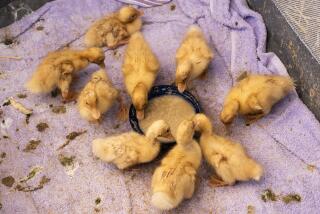For woodchuck rescuer, every day is Groundhog Day
Reporting from Dunkirk, N.Y. — Sixteen years ago, Bob Will came home to find a basket outside his house. He peered inside and saw a groundhog with two broken legs.
Will was surprised, but not by what was in the basket. He’s used to people leaving groundhogs at his door.
But there was no note explaining who had left the groundhog or how it might have been injured, and that shocked him. “There wasn’t even a phone number, and nobody ever checked to see what happened to him,” Will said, shaking his head.
How, he wonders to this day, could someone leave a wounded woodchuck on his doorstep without following up on the animal’s fate?
Will’s passion for groundhogs — aka woodchucks — amounts to what some consider an obsession but what he says is his calling. Each year about this time, in the run-up to Groundhog Day on Feb. 2, this calling turns a spotlight on Will and the multitude of sick, maimed or just plain helpless marmots sharing his home on the icy shores of Lake Erie.
If legend holds true, a groundhog dubbed Dunkirk Dave who’s hibernating a few feet from Will’s front door will poke his head from the earth on Feb. 2, the midway point between the winter solstice and spring equinox. If he sees his shadow, winter weather will endure another six weeks. If no shadow appears, spring temperatures are on their way.
By daybreak, TV trucks will be parked on Will’s property to cover the event, which is far less manic than the Groundhog Day festivities starring Punxsutawney Phil in Pennsylvania, but which has grown in popularity around here along with Dunkirk Dave’s fame.
But in truth, Will says, every day is Groundhog Day at his house. It has been that way for decades, since as a child he brought a bloodied groundhog home, nursed it back to health, and released it to the safety of a friend’s property a few months later.
“I’ve helped thousands and thousands of woodchucks,” said Will, a slender man with white hair and bright blue eyes. “I didn’t do it for the fame, because there wasn’t any. I did it because I enjoyed it. I’ve probably disappointed my parents that I devoted so much of my life to animals, but I figure you’ve got one chance in life. You should do something you love, and you’ve got to feel like what you’re doing is the right thing to do.”
“Especially for her,” said fellow groundhog whisperer Bill Verge, looking down at the floor where Sidewinder — so named because a farmer’s bullet left her unable to walk straight — did circles on the carpet. “She’d be lost without someone to take care of her.”
Outside, a fierce storm blew snow across the yard, and Lake Erie churned angry gray waves onto the shore. Squirrels dashed through the whiteout to pluck nuts from the feeders next to Dunkirk Dave’ hibernation hole.
Inside, the house was warm and slightly musky smelling, and groundhogs in various states of disrepair snoozed, waddled around, or nibbled at treats as Will and Verge, who is Will’s assistant, tended them and explained how this became groundhog central.
Will, 70, grew up amid these farms and country roads, where it wasn’t unusual to see small animals dead or wounded — victims of cars, larger beasts, hunters or farmers determined to keep rodents off their land. But while most animals had devoted advocates or hunting restrictions protecting them, nobody was watching the woodchucks.
“You’d see one walking down the road with a broken leg and other people would say, ‘Oh, it’s just a groundhog.’ Just a groundhog?! It’s one of God’s creatures,” said Will. Some see them as nuisance rodents whose holes trip up horses and whose vegetarian diets destroy crops, but he insists otherwise.
“They’re very clean, they mind their own business, and they’re the only animal to be honored with their own day on the calendar,” said Will, who has confronted farmers targeting groundhogs and lectured them. “They’re not trash just to be thrown away in a pond because a farmer doesn’t like them because they ate his lettuce. I just love the darned things.”
Will credits his parents with encouraging his interest in helping not just groundhogs, but every animal. Someone once left a turtle with no eyes outside his house with a note that read: “Help me.” Over the years, he has taken in a pig, a monkey and a one-winged pigeon that lived with him 12 years.
“She was the happiest bird in the cage — had lots of babies too!” Will said of the pigeon. He saved her life by having her broken wing amputated rather than letting a veterinarian wring her neck.
But it is the groundhogs that touch him the most.
Sometimes they are left at his door. Sometimes people call from hundreds of miles away with an ailing groundhog to be picked up. Some wash in from the lake, and some drop from the sky, literally. Birds of prey often pick up small groundhogs but lose them in flight.
The lucky ones are brought to Will and Verge, who have tales of miraculous saves. One groundhog was scooped up by a large plow after a blizzard and nearly died in a snowdrift until someone spotted it and called Will.
His current charges include Fanny, caught in an engine fan blade; Sidewinder, shot in the head; Sweetie, orphaned when her mother was killed by a car; and a paraplegic groundhog named Pooperdoo whose spinal cord was severed by a bullet. He pulls himself across the floor with his muscular front end and arches his head in pleasure when someone scratches him between his round ears.
There are more, but Will, a licensed wildlife rehabilitator, won’t say how many. He doesn’t want to upset neighbors who see groundhogs as pests.
To the non-expert eye, most of the groundhogs look alike except for the scars from their injuries, their varying sizes — they range from a couple of pounds to about 15 pounds — and the limps and other quirks resulting from battered bodies and brains. But Verge and Will say each is unique. Some are more blond than brown — there are even albino groundhogs. Some relish having their heads scratched or their broad backs stroked. Others bite.
Will releases groundhogs onto a friend’s farm when they are healthy. Woody, the groundhog left in the basket on his doorstep in 1996, lived with him three years until he was well enough to go free.
But often he cares for the animals for life because their injuries have left them unable to survive in the wild.
It’s time-consuming, expensive, and worrying to his 91-year-old father, whom Will visits at his home each day. “Dad would have liked me to get married,” he said with a sigh.
There are no vacations. Some groundhogs require feeding every three or four hours. There is medicine to be administered, cages to be cleaned, claws to be clipped, teeth to be ground down. When the weather warms, there’s a groundhog playground in Will’s backyard.
Will, a retired teacher of special-needs children, has a business repairing old Smith-Corona typewriters, which helps pay for the hundreds of pounds of pecans, macadamias and acorns he goes through each month. He shops online for the best prices, but that doesn’t always work out. Will thought he had a good deal with a recent purchase of macadamia nuts from Hawaii until he realized they hadn’t been shelled.
“I didn’t read the fine print,” said Will, who is still trying to figure out how to extract all those nuts.
The hardest part of his passion, though, is grieving for the groundhogs who don’t survive their injuries, or who die of old age long after Will has nursed them through their wounds and adopted them into his household.
“I go to pieces,” Will said. “John Boehner and I have a similar problem,” he added, referring to the Republican House speaker famous for his public weeping.
After it dies, each groundhog is wrapped in a new blanket and gently lowered into the earth in Will’s yard. Sometimes, he says a prayer for the newly departed. Sometimes, when the groundhog has had a special place in his heart, he can’t bear to look at it lying in its little grave.
“The grief is the price you pay at the end,” he said as Sidewinder circled at his feet. “But it’s worth it.”
More to Read
Sign up for Essential California
The most important California stories and recommendations in your inbox every morning.
You may occasionally receive promotional content from the Los Angeles Times.











